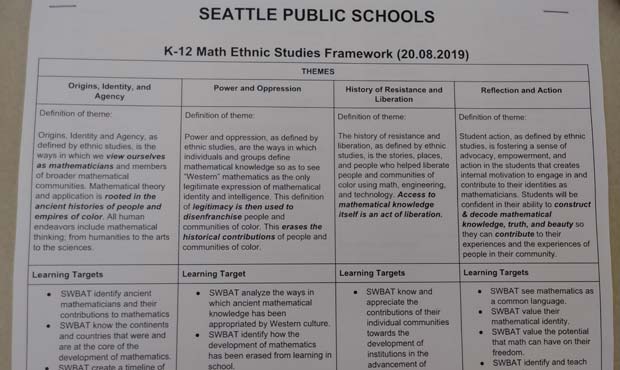In Seattle Public Schools, math is a racist tool used to oppress minorities and perpetuate America’s white supremacist society.
Thankfully, the district’s K-12 Math Ethnic Studies Framework helps students “identify economic movements that have led to liberation” and ways to “suggest resolutions to oppressive mathematical practices.”
This document is really something. If you want to end oppression, maybe spend classroom time teaching kids actual math, instead of all the ways it allegedly harms them?
“SEATTLE PUBLIC SCHOOLS
K-12 Math Ethnic Studies Framework (20.08.2019)” https://t.co/R9umTkIiCC— Mark Hemingway (@Heminator) October 1, 2019
“This document is really something,” Mark Hemingway, senior writer at Real Clear Investigations, posted to Twitter, along with a link to the framework. “If you want to end oppression, maybe spend classroom time teaching kids actual math, instead of all the ways it allegedly harms them?”
The framework outlines four themes to the Math Ethnic Studies Framework, as well as “learning targets” and “essential questions” to get youngsters thinking about how “western” math is “used to disenfranchise people and communities of color.”
“Mathematical theory and application is rooted in the ancient histories of people and empires of color. All human endeavors include mathematical thinking; from humanities to the arts to the sciences,” according to the curriculum.
 But “Western” society has co-opted math to use it as a tool of power and oppression to hold back blacks and other minorities, students learn.
But “Western” society has co-opted math to use it as a tool of power and oppression to hold back blacks and other minorities, students learn.
“Power and oppression, as defined by ethnic studies, are the ways in which individuals and groups define mathematical knowledge so as to see ‘Western’ mathematics as the only legitimate expression of mathematical identity and intelligence,” the document explains. “This definition of legitimacy is then used to disenfranchise people and communities of color. This erases the historical contributions of people of color.”
Under the “Power and Oppression” learning target, “students will be able to analyze the ways in which ancient mathematical knowledge has been appropriated by Western culture,” according to the framework.
Students also learn to “identify how the development of mathematics has been erased from learning in school,” along with “how math has been and continues to be used to oppress and marginalize people and communities of color.”
Math is closely connected to science and technology, which are also racist tools to oppress blacks through the “systems of power” in the U.S. that “deny access to mathematical knowledge to people and communities of color,” according to Seattle Public Schools.
Standardized testing, math used in natural resources management and economics are part of the white supremacist system, as well, the curriculum suggests.
Some “essential questions” students should ponder next time they break out their math book:
“Is there an authority for math knowledge?”
“How do we derive mathematical truth?”
“Who holds the power in a mathematical classroom?”
“Who gets to say if an answer is right?”
“What is the process for verifying the truth?”
“Can you recognize and name oppressive mathematical practices in your experience?”
“How is math manipulated to allow inequality and oppression to persist?”
“Who is doing the oppressing?”
“Where is there an opportunity to examine systemic oppression?”
“How can math help us understand the impact of economic conditions and systems that contribute to poverty and slave labor?”
“How can we use data to resist and liberate?”
Ultimately, the goal is student “reflection and action” that leverages the ethnic studies in a quest for “resistance and liberation” from America’s white supremacist system, the framework suggests.
“Student action, as defined by ethnic studies, is fostering a sense of advocacy, empowerment, and action in the students that creates internal motivation to engage in and contribute to their identities as mathematicians,” the document reads. “Students will be confident in their ability to construct and decode mathematical knowledge, truth, and beauty so they can contribute to their experience and the experiences of people in their community.”
Meanwhile, The Seattle Times reports the school district’s racial achievement gap in math continues to expand.
“Over the past four years, racial achievement gaps in math and English also widened slightly. The district measures the gaps by calculating the difference between average proficiency on state exams for White/Asian students and Black, Hispanic/Latino, Native American and Pacific Islander students,” the Times reported last November.
Last school year, the gap for math was nearly 40 percent, while in the 2014-15 school year it was 38.3 percent, according to the new site.

Leave a Comment
COMMENTS POLICY: We have no tolerance for messages of violence, racism, vulgarity, obscenity or other such discourteous behavior. Thank you for contributing to a respectful and useful online dialogue.